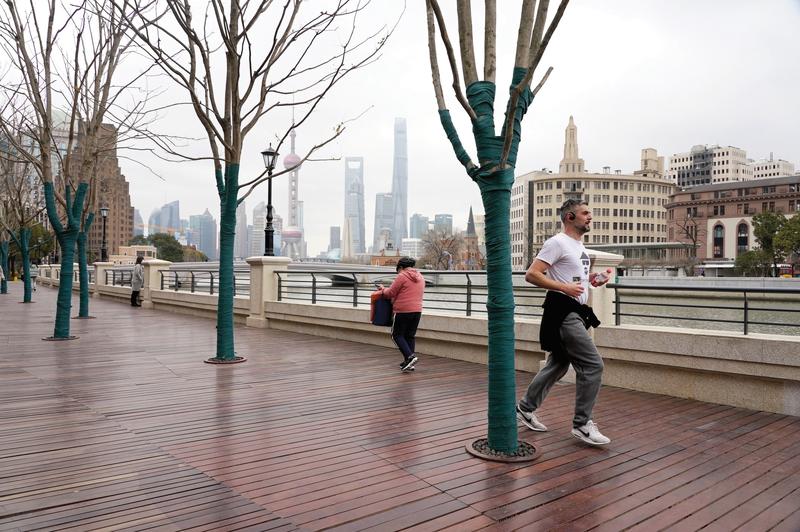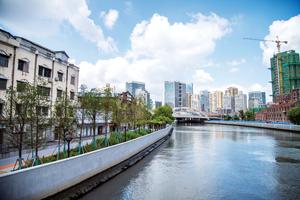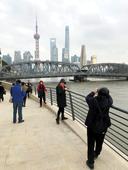 A section of the Suzhou Creek in Shanghai has been refreshed thanks to recent municipal efforts. (PHOTO PROVIDED TO CHINA DAILY)
A section of the Suzhou Creek in Shanghai has been refreshed thanks to recent municipal efforts. (PHOTO PROVIDED TO CHINA DAILY)
The completion of a 42-kilometer waterfront pedestrian path along Suzhou Creek in Shanghai in December marked another milestone in the ambitious redevelopment project of the banks of the Huangpu River and Suzhou Creek in the city.
The aim of the “River and Creek” project, which started five years ago, involves adding more greenery to the landscape, renovating historical buildings and industrial structures, breaking down walls and constructing new bridges to connect public spaces along the river.
Starting from the Linkong Musical Park at the intersection of Suzhou Creek and the city’s west outer ring road, the newly connected riverside path extends to the Waibaidu Bridge at the north part of the Bund, where the creek meets the Huangpu River.
Several parts of the riverside path which were built before the project commenced have been renovated and expanded, alleviating the pressure caused by high density develop-ment in the downtown area.
“Before the project was launched, a total (of) 15.3 kilometers and 63 spots along the creek were blocked by historic buildings, warehouses, residential quarters and other human-made obstacles,” said Zhu Jianhao, executive deputy director of the project, who is also the deputy director of the municipal housing and urban-rural development commission.
“The project has been supported by district governments, companies and residents along the river because the building of the pathway involved the opening of many internal spaces.”
 An expat takes his exercise to the newly renovated bank of Suzhou Creek on Jan 20. (GAO ERQIANG / CHINA DAILY)
An expat takes his exercise to the newly renovated bank of Suzhou Creek on Jan 20. (GAO ERQIANG / CHINA DAILY)
Because of these developments, people can now perform various activities along the path such as jogging, dancing, playing music and skateboarding.
“The waterfront area of the creek will become a ‘backyard garden’ of local citizens, while the Huangpu River waterfront serves as a ‘reception room’,” added Zhu.
“We will strive to turn the riverside from an ‘industrial rust belt’ into a vibrant urban public space for leisure.”
Chen Zhiyong, the owner of a small store near the creek, said the new path presents a stark contrast to its former self. Three years ago, the area had nothing but a narrow pedestrian sidewalk, a parking lot, a small office building and a water quality monitor facility.
“This place used to be a wasteland full of deserted shared bikes,” he said, referring to a park by the bridge of Sichuan North Road where he often brings his children to play nowadays.
“Now, it has become this beautiful green area with very good facilities, such as benches and scenic platforms.”
According to Wang Lin, chief designer of the 900-meter waterfront section at Suzhou Creek in Hongkou district, the purpose of the redevelopment project is to “give the riverside back to the people”.
For his section of the creek, the width of the sidewalk was expanded to up to 5 meters and the previous parking lot was turned into a 460-square-meter elevated platform for sightseeing.
With the iconic skyline of Shanghai’s Lujiazui business district in the background, this area will be among the best spots in the city to take photos, Wang said.
 Local residents enjoy leisure moments on the newly renovated bank of Suzhou Creek last week. (XING YI / CHINA DAILY)
Local residents enjoy leisure moments on the newly renovated bank of Suzhou Creek last week. (XING YI / CHINA DAILY)
Today, following the changes that have taken place because of the redevelopment project, wandering along the waterfront in Jing’an district is akin to tracing the history of the city’s emerging national industry in the early 20th century.
Here, the 6.3-km path links a dozen heritage industrial structures, including the art-deco building that housed the former Shanghai Chamber of Commerce, the Joint Trust Warehouse, which was known as Sihang Warehouse during the Japanese invasion of the city, and the Fuxin Flour Mill, which was once the biggest flour mill in China.
Artworks, such as paintings of new and old Shanghai and installation pieces, have also been introduced to breathe new life into the area.
Zhong Lyu, chef designer of the Jing’an section, said a lot of attention was paid to details such as the decorations and colors of the parapet, pathways and the surrounding areas, so that the new and the old would blend harmoniously with one another.
In Putuo district, which accounts for half of the redevelopment project, connecting the pathways involved much negotiation and communication with companies, institutions and local residents.
Wang Zhedong, who lives in Peninsula Garden, formerly a closed residential neighborhood beside the creek in Putuo, said he was worried about the opening up of the creek banks in the community due to safety concerns.
“But the local government showed us the plan and made adjustments according to our feedback, and when the renovation project was done, I found the riverside had become more beautiful,” he said.
“At the beginning, we residents thought that we’d lose some privacy with the opening up of the community, but in the end we feel that the project has actually given us more space. We now have a much longer riverside to stroll and relax in,” Wang said.
In Putuo, around 14 residential neighborhoods and eight institutions and companies, such as the East China University of Political Science and Law, Shanghai Banknote Printing Co and the M50 Creative Park have agreed to take down their concrete walls and open their internal spaces to provide the public access to the riverside.
“The project could not have been completed without the understanding and cooperation for the opening of the pathway,” said Zhang Yuxin, deputy governor of the district.
He Chunming, who has lived near the river most of his life, said he used to be able to swim in the creek when he was a child, but this stopped when the water got severely polluted in the 1980s.
A huge clean-up project was launched in 1996 and billions of yuan were channelled into a project that involved building sewage pipes and wastewater treatment facilities.
The fourth phase of the comprehensive cleanup project was launched in 2018 with the aim of eliminating water rated below Grade V,
the lowest of the five-tiered national standards, from the Suzhou Creek by 2021.
“In the past five years, the water has gradually become clear again and the stench has disappeared,” said the 66-year-old He. “There are now many small parks along the new pathway, and it has made our mother river pretty again.”


